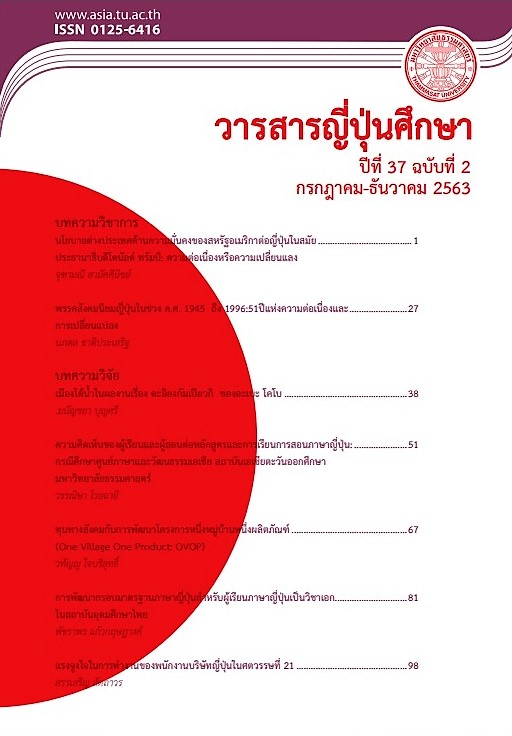Social Capital and Developing the One Village One Product (OVOP) Project
Keywords:
ทุนทางสังคม, การพัฒนา, โครงการหนึ่งหมู่บ้านหนึ่งผลิตภัณฑ์Abstract
This article examines and analyzes developing social capital that exists in communities into the OVOP project. It is a qualitative research collecting data from in - depth interviews together with a documentary research, then making an analysis using the social capital concept. The finding reveals that a success of OVOP comes from developing social capital that exists in communities into the OVOP project under the following components of the social capital concept. First, trust is built on teamwork or forming groups such as co-operatives. It can be said that the OVOP project has an institutional mechanism to operate and resolve internal problems actively. Next, norms emerge from mutual helping among people in communities having strict rules, a clear division of work and an institutional mechanism to sustain their existing norms. Last, network is naturally created by people in communities connecting through internal and external groups.
Downloads
References
ฉัตรทิพย์ นาถสุภา. (2553). การเป็นสมัยใหม่กับแนวคิดชุมชน. กรุงเทพฯ: บริษัทสำนักพิมพ์สร้างสรรค์จำกัด.
ฉวีวรรณ เด่นไพบูลย์. รองศาสตราจารย์ คณะสถาปัตยกรรมศาสตร์ จุฬาลงกรณ์มหาวิทยาลัยและเครือข่าย International OVOP Policy Association (IOPA). (8 มกราคม 2019). สัมภาษณ์.
ตฤณ สุขนวล. (2545). ตัวตนคนไม้เรียง: วิถีทางชุมชนพึ่งตนเอง. กรุงเทพฯ: รวมทัศน์.
ฑิตยา สุวรรณชฏ. (2544). แนวคิดทฤษฎีสังคม. กรุงเทพฯ: สถาบันบัณฑิตพัฒนบริหารศาสตร์.
ธีรรัตน์ ชิณแสน. นักวิชาการการเกษตร กรมวิชาการเกษตร กระทรวงเกษตรและสหกรณ์. (30 มีนาคม 2562). สัมภาษณ์.
ปัณณพงศ์ วงศ์ณาศรี. (2559). ทุนทางสังคมกับข้อเสนอเชิงนโยบายของการบูรณาการทุนทางสังคมเพื่อการพัฒนาท้องถิ่น. สารอาศรมวัฒนธรรมวลัยลักษณ์. 16(1) ม.ค. – มิ.ย., 99 – 114.
พระมหาอภิเดช เนตรวิลา. (2549). ลักษณะของทุนทางสังคมและการปรับใช้เพื่อการพัฒนาชุมชนให้เข้มแข็ง: กรณีศึกษาบ้านหนองโสภณ อำเภอมัญจาคีรี จังหวัขอนแก่น. ภาคนิพนธ์ศิลปศาสตร์มหาบัณฑิต คณะพัฒนาสังคมและสิ่งแวดล้อม สถาบันบัณฑิตพัฒนบริหารศาสตร์.
พีระ ลิ่วลม. (2542). การศึกษาศักยภาพของทุนทางสังคมของชุมชนไซเบอร์. วิทยานิพนธ์ ปริญญา มหาบัณฑิต มหาวิทยาลัยมหิดล.
พัทยา สายหู. (2544). กลไกสังคม. กรุงเทพฯ: จุฬาลงกรณ์มหาวิทยาลัย.
มิ่งสรรพ์ ขาวสอาด. (2542). ใน พูนสิน วงศ์กลธูต (บก.) ครบรอบ 60 ปี อาจารย์อัมมาร. กรุงเทพฯ: สถาบันวิจัยเพื่อการพัฒนาประเทศไทย.
สมชาย ชคตระการ และคณะ. (2549). สหกรณ์การเกษตรของประเทศญี่ปุ่น. วารสารญี่ปุ่นศึกษา. 2/2549. 125-160.
สมชาย ชคตระการ. อาจารย์ประจำคณะวิทยาศาสตร์และเทคโนโลยี มหาวิทยาลัยธรรมศาสตร์ อดีตนายกสมาคมนักเรียนไทยในประเทศญี่ปุ่นในพระบรมราชูปถัมภ์. (20 มีนาคม 2562). สัมภาษณ์.
หงษ์ฟ้า ทรัพย์บุญเรือง. อาจารย์ประจำคณะเศรษฐศาสตร์ มหาวิทยาลัยธรรมศาสตร์. (19 กุมภาพันธ์ 2562). สัมภาษณ์.
เสรี พงศ์พิศ. (2548). วัฒนธรรมองค์กรของโลกยุคใหม่: เครือข่าย: ยุทธวิธีเพื่อประชาคมเข้มข้น ชุมชนเข้มแข็ง. กรุงเทพฯ: สถาบันส่งเสริมวิสาหกิจชุมชน.
อานันท์ กาญจนพันธุ์. (2544). มิติชุมชน วิธีคิดท้องถิ่นว่าด้วย สิทธิ อำนาจ และการจัดการทรัพยากร. กรุงเทพฯ: สำนักงานกองทุนสนับสนุนการวิจัย.
Coleman, J. S. (1988). Social Capital in the Creation of Human Capital. In Social Capital: A Multifaceted Perspectives. Dasgupta, P. and Serageldin, I. eds. Washington D.C.: World Bank.
Haraguchi, N. (2008). The One-Village-One-Product (OVOP) movement: What it is, how it has been replicated, and recommendations for a UNIDO OVOP-type project. Vienna: UNIDO.
Harashima, A. (2012). The Role of Agricultural Cooperatives in Local Development. The OVOP Movement and Local Development in Asia-How to Nurture Rural Entrepreneurs in the Developing World, Igusa, K. (eds.). Oita: Ritsumeikan Asia Pacific University.
Hiramatsu, M. (2008). One Village, One Product Spreading throughout the World. Oita Japan: Office: Oita OVOP International Exchange Promotion Committee.
Matsui, K. (2011). Regional development in japan and the one village one product movement-a proloque. In Igusa, K. (Ed.). The ovop movement and local development in Asia-how to nurture rural entrepreneurs in the developing World. Oita: Ritsumeikan Asia Pacific University.
Matsui, K. (2012). Locality and Dynamics in OVOP Promotion: Oita’s Experince for Regional Development in Developing Countries. Significance of the Regional One-Product Policy: How to Use the OVOP/OTOP Movements, Murayama, H. (eds.). Pathumthani: Thammasat Printing House.
Nobuyoshi, N. & Lutful, K. (2005). One Village One Product Movement: Success Story of Rural Development in Japan and Learning Points for Bangladesh. The Economic science. Vol. 52(4), 71-92.
Oita OVOP International Exchange Promotion Committee. Retrieved March 8, 2016 from http://www.ovop.jp/en/
Putnam, R. D. (1993). The prosperous Community: Social Capital and Public Life. Retrieved March 28, 2016 from http://www.philia.ca.
Schumann, Fred R. (2016). A Study of One Village One Product (OVOP) and Workforce Development: Lessons for Engaging Rural Communities around the World. Guam: University of Guam.
Takai, K. (2012). Endogenous Regional Development. Tokyo: UNCRD.
Yamazaki, J. (2010). A Comparative Analysis of One Village One Product (OVOP) and its Replicability in International Development. Thesis (MA) Institute of Social Studies, The Hague.




